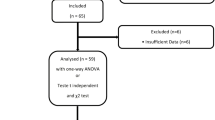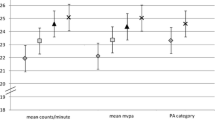Abstract
Elevated fasting plasma homocysteine (Hcy) level is a vascular disease risk factor. Plasma Hcy is affected by 5,10-methylenetetrahydofolate reductase (MTHFR) genotype and dietary folate intake. This cross-sectional study in 434 Japanese adults examined the associations among objectively measured physical activity (PA), plasma Hcy adjusting for dietary folate intake, and MTHFR C677T genotype. Daily PA was measured by triaxial accelerometry and all subjects completed a questionnaire about their dietary habits. Plasma Hcy and MTHFR C677T genotype were determined. Plasma Hcy in subjects with the TT genotype was significantly higher than in those with CC or CT genotype (p < 0.001). Plasma Hcy was significantly different between ≥200 (7.6 ± 0.2 nmol/mL) and <200 µg/day (8.3 ± 0.3 nmol/mL) folate intake groups (p = 0.003). There were no differences in plasma Hcy adjusting for age, sex, and folate intake between groups according to PA category in all subjects. However, there were significant interactions between time spent in light PA (p = 0.003), vigorous PA (p = 0.001), or inactivity (p = 0.004), and MTHFR genotype. In only the TT genotype, shorter time spent in light PA was associated with higher plasma Hcy than a longer time spent in light PA (11.5 ± 3.3 nmol/mL vs. 8.5 ± 3.3 nmol/mL, p < 0.001), and longer time spent in vigorous PA and inactivity were associated with higher plasma Hcy (11.8 ± 3.3 nmol/mL vs. 8.4 ± 3.2 nmol/mL, 11.6 ± 3.3 nmol/mL vs. 8.4 ± 3.3 nmol/mL, respectively, p < 0.001). In conclusion, light and vigorous PA were associated with plasma Hcy only in the TT genotype, but there were no such associations in all genotypes.

Similar content being viewed by others
References
Bathum L, Petersen I, Christiansen L, Konieczna A, Sorensen TI, Kyvik KO (2007) Genetic and environmental influences on plasma homocysteine: results from a danish twin study. Clin Chem 53(5):971–979
Boushey CJ, Beresford SA, Omenn GS, Motulsky AG (1995) A quantitative assessment of plasma homocysteine as a risk factor for vascular disease. Probable benefits of increasing folic acid intakes. Jama 274(13):1049–1057
Castro R, Rivera I, Blom HJ, Jakobs C, Tavares de Almeida I (2006) Homocysteine metabolism, hyperhomocysteinaemia and vascular disease: an overview. J Inherit Metab Dis 29(1):3–20
Dankner R, Chetrit A, Ken Dror G, Sela BA (2007) Physical activity is inversely associated with total homocysteine levels, independent of c677t mthfr genotype and plasma b vitamins. Age (Dordr) 29(4):219–227
de Bree A, Verschuren WM, Blom HJ, Kromhout D (2001) Lifestyle factors and plasma homocysteine concentrations in a general population sample. Am J Epidemiol 154(2):150–154
Freedson PS, Melanson E, Sirard J (1998) Calibration of the computer science and applications, inc. Accelerometer. Med Sci Sports Exerc 30(13):777–781
Gando Y, Kawano H, Yamamoto K, Sanada K, Tanimoto M, Oh T, Ohmori Y, Miyatani M, Usui C, Takahashi E, Tabata I, Higuchi M, Miyachi M (2009) Age and cardiorespiratory fitness are associated with arterial stiffening and left ventricular remodelling. J Hum Hypertens 24(3):197–206
Ganji V, Kafai MR (2003) Demographic, health, lifestyle, and blood vitamin determinants of serum total homocysteine concentrations in the third national health and nutrition examination survey, 1988–1994. Am J Clin Nutr 77(4):826–833
Holm PI, Bleie O, Ueland PM, Lien EA, Refsum H, Nordrehaug JE, Nygard O (2004) Betaine as a determinant of postmethionine load total plasma homocysteine before and after b-vitamin supplementation. Arterioscler Thromb Vasc Biol 24(2):301–307
Homosysteine Studies Collaboration (2002) Homocysteine and risk of ischemic heart disease and stroke: a meta-analysis. Jama 288(16):2015–2022
Husemoen LL, Thomsen TF, Fenger M, Jorgensen T (2004) Effect of lifestyle factors on plasma total homocysteine concentrations in relation to mthfr(c677t) genotype. Inter99 (7). Eur J Clin Nutr 58(8):1142–1150
Hustad S, Midttun O, Schneede J, Vollset SE, Grotmol T, Ueland PM (2007) The methylenetetrahydrofolate reductase 677c– > t polymorphism as a modulator of a b vitamin network with major effects on homocysteine metabolism. Am J Hum Genet 80(5):846–855
Iemitsu M, Maeda S, Otsuki T, Sugawara J, Tanabe T, Jesmin S, Kuno S, Ajisaka R, Miyauchi T, Matsuda M (2006) Polymorphism in endothelin-related genes limits exercise-induced decreases in arterial stiffness in older subjects. Hypertension 47(5):928–936
Jacques PF, Bostom AG, Wilson PW, Rich S, Rosenberg IH, Selhub J (2001) Determinants of plasma total homocysteine concentration in the framingham offspring cohort. Am J Clin Nutr 73(3):613–621
Joubert LM, Manore MM (2008) The role of physical activity level and b-vitamin status on blood homocysteine levels. Med Sci Sports Exerc 40(11):1923–1931
Konstantinova SV, Tell GS, Vollset SE, Nygard O, Bleie O, Ueland PM (2008) Divergent associations of plasma choline and betaine with components of metabolic syndrome in middle age and elderly men and women. J Nutr 138(5):914–920
Kuo HK, Yen CJ, Bean JF (2005) Levels of homocysteine are inversely associated with cardiovascular fitness in women, but not in men: data from the national health and nutrition examination survey 1999–2002. J Intern Med 258(4):328–335
Labayen I, Olsson LA, Ortega FB, Nilsson TK, Sjostrom M, Lucia A, Ruiz JR (2010) Cardiorespiratory fitness modifies the association between the ucp3-55>t (rs1800849) polymorphism and plasma homocysteine in swedish youth. Atherosclerosis 210(1):183–187
Lange LA, Croteau-Chonka DC, Marvelle AF, Qin L, Gaulton KJ, Kuzawa CW, McDade TW, Wang Y, Li Y, Levy S, Borja JB, Lange EM, Adair LS, Molke KL (2010) Genome-wide association study of homocysteine levels in Filipinos provides evidence for CPS1 in women and a stronger MTHFR effect in young adults. Hum Mol Genet 19(10):2050–2058
Meleady R, Ueland PM, Blom H, Whitehead AS, Refsum H, Daly LE, Vollset SE, Donohue C, Giesendorf B, Graham IM, Ulvik A, Zhang Y, Bjorke Monsen AL (2003) Thermolabile methylenetetrahydrofolate reductase, homocysteine, and cardiovascular disease risk: the European concerted action project. Am J Clin Nutr 77(1):63–70
Misono M, Maeda S, Iemitsu M, Nakata Y, Otsuki T, Sugawara J, Zempo H, Yoshizawa M, Miyaki A, Kuno S, Matsuda M, Ajisaka R (2009) Combination of polymorphisms in the beta2-adrenergic receptor and nitric oxide synthase 3 genes increases the risk for hypertension. J Hypertens 27(7):1377–1383
Mudd SH, Poole JR (1975) Labile methyl balances for normal humans on various dietary regimens. Metabolism 24(6):721–735
Mudd SH, Ebert MH, Scriver CR (1980) Labile methyl group balances in the human: the role of sarcosine. Metabolism 29(8):707–720
Nygard O, Vollset SE, Refsum H, Stensvold I, Tverdal A, Nordrehaug JE, Ueland M, Kvale G (1995) Total plasma homocysteine and cardiovascular risk profile. The hordaland homocysteine study. Jama 274(19):1526–1533
Nygard O, Refsum H, Ueland PM, Vollset SE (1998) Major lifestyle determinants of plasma total homocysteine distribution: the hordaland homocysteine study. Am J Clin Nutr 67(2):263–270
Okubo H, Sasaki S, Rafamantanantsoa HH, Ishikawa-Takata K, Okazaki H, Tabata I (2008) Validation of self-reported energy intake by a self-administered diet history questionnaire using the doubly labeled water method in 140 japanese adults. Eur J Clin Nutr 62(11):1343–1350
Olthof MR, Verhoef P (2005) Effects of betaine intake on plasma homocysteine concentrations and consequences for health. Curr Drug Metab 6(1):15–22
Rowe DA, Mahar MT, Raedeke TD, Lore J (2004) Measuring physical activity in children with pedometers: reliability, reactivity, and replacement of missing data. Pediatric Exerc Sci 16:343–354
Ruiz JR, Hurtig-Wennlof A, Ortega FB, Patterson E, Nilsson TK, Castillo MJ, Sjostrom M (2007a) Homocysteine levels in children and adolescents are associated with the methylenetetrahydrofolate reductase 677c-->t genotype, but not with physical activity, fitness or fatness: the European youth heart study. Br J Nutr 97(2):255–262
Ruiz JR, Sola R, Gonzalez-Gross M, Ortega FB, Vicente-Rodriguez G, Garcia-Fuentes M, Gutierrez A, Sjostrom M, Pietrzik K, Castillo MJ (2007b) Cardiovascular fitness is negatively associated with homocysteine levels in female adolescents. Arch Pediatr Adolesc Med 161(2):166–171
Sasaki S, Ushio F, Amano K, Morihara M, Todoriki O, Uehara Y, Toyooka E (2000) Serum biomarker-based validation of a self-administered diet history questionnaire for Japanese subjects. J Nutr Sci Vitaminol (Tokyo) 46(6):285–296
Saw SM, Yuan JM, Ong CN, Arakawa K, Lee HP, Coetzee GA, Yu MC (2001) Genetic, dietary, and other lifestyle determinants of plasma homocysteine concentrations in middle-aged and older Chinese men and women in Singapore. Am J Clin Nutr 73(2):232–239
Wyss M, Kaddurah-Daouk R (2000) Creatine and creatinine metabolism. Physiol Rev 80(3):1107–1213
Yamada Y, Yokoyama K, Noriyasu R, Osaki T, Adachi T, Itoi A, Naito Y, Morimoto T, Kimura M, Oda S (2009) Light-intensity activities are important for estimating physical activity energy expenditure using uniaxial and triaxial accelerometers. Eur J Appl Physiol 105(1):141–152
Yang QH, Botto LD, Gallagher M, Friedman JM, Sanders CL, Koontz D, Nikolova S, Erickson JD, Steinberg K (2008) Prevalence and effects of gene-gene and gene-nutrient interactions on serum folate and serum total homocysteine concentrations in the united states: findings from the third national health and nutrition examination survey DNA bank. Am J Clin Nutr 88(1):232–246
Acknowledgments
The authors would like to express their appreciation to the participants in this study. This study was supported by a Grant-in-Aid for Scientific Research (#20300231, M. Miyachi, #18200041, H. Shibayama, #22700708, H. Murakami) from the Ministry of Education, Culture, Sports, Science, and Technology, Japan and a Grant-in-Aid for Scientific Research from the Ministry of Health, Labor, and Welfare of Japan (M. Miyachi). The authors declare that they have no conflicts of interest.
Author information
Authors and Affiliations
Corresponding author
Additional information
Communicated by Klaas R Westerterp.
Rights and permissions
About this article
Cite this article
Murakami, H., Iemitsu, M., Sanada, K. et al. Associations among objectively measured physical activity, fasting plasma homocysteine concentration, and MTHFR C677T genotype. Eur J Appl Physiol 111, 2997–3005 (2011). https://doi.org/10.1007/s00421-011-1926-z
Received:
Accepted:
Published:
Issue Date:
DOI: https://doi.org/10.1007/s00421-011-1926-z




